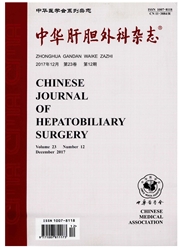

 中文摘要:
中文摘要:
目的构建携带反义多药耐药相关蛋白(MRP)基因的重组腺病毒微球并进行理化性质的鉴定,以用于肝癌多药耐药的基因治疗研究。方法采用可降解的生物材料聚乳酸-聚乙烯醇(PELA)包被携带反义MRP基因的重组腺病毒制成微球,体外测定微球的粒径、载病毒量、包封率及释放规律,并用其转染人肝癌耐药细胞株HepG2/ADM,48h及120h后检测转染细胞荧光强度。结果成功地构建了携带反义MRP基因的重组腺病毒微球,直径约1.765μm,包封率为52.4%,载病毒率为5.5 ×10^8 efu/mg,在120h内释放病毒量为49.2%,总的释放时间长于240h。释放出的病毒保持活性,10mg微球48h释放病毒滴度为1.0×10^9efu/ml,对HepG2/ADM细胞株转导效率可达90%以上。结论聚乳酸-聚乙烯醇共聚物(PELA)包载反义RNA重组腺病毒制备的微球,包封率较高,载病毒量较大,能保持病毒活性,较长时间释放,转导效率高,可望有效地将反义MRP导入人肝癌耐药细胞株,为进一步研究肝癌耐药机制及其逆转方式提供实验基础。
 英文摘要:
英文摘要:
Objective To construct the microsphere encapsulated recombinant adenovirus (rAdV) carrying antisense MRP (as-mrp) for the gene therapy to overcome drug resistance in hepatocellular carcinoma. Methods Microsphere was made by using degradable biomaterial poly-DL-lactidepoly (ethylene-glycol) and encapsulated as-mrp rAdV and its diameter and the encapsulating rate were tested. The releasing test and the bioactivity of viruses incorporated were studied in vitro. The transfected cells were observed for fluorescence intensity at 48 and 120 h after transfecting HepG2/ADM. Results Microsphere encapsulated as-mrp rAdV was constructed successfully and its diameter was about 1. 765 um, encapsulated rate 52. 4%, carrying viral rate 5. 5 × 10^8 efu/mg. The release test showed that the adenovirus released more than 240 h and 50% were shed within the first 120 h. Their activity was retained and more than 90% of the HepG2/ADM ceils could be transfected when the 10 mg microsphere was used. Conclusion Microsphere encapsulation of recombinant adenovirus carrying antisense MRP is an effective vector retaining highly viral bioactivity and can effectively reverse HepG2/ADM cells, which would provide experimental basis for the mechanisms and reversal Methods of the multidrug resistance in human hepatocellular carcinoma.
 同期刊论文项目
同期刊论文项目
 同项目期刊论文
同项目期刊论文
 期刊信息
期刊信息
